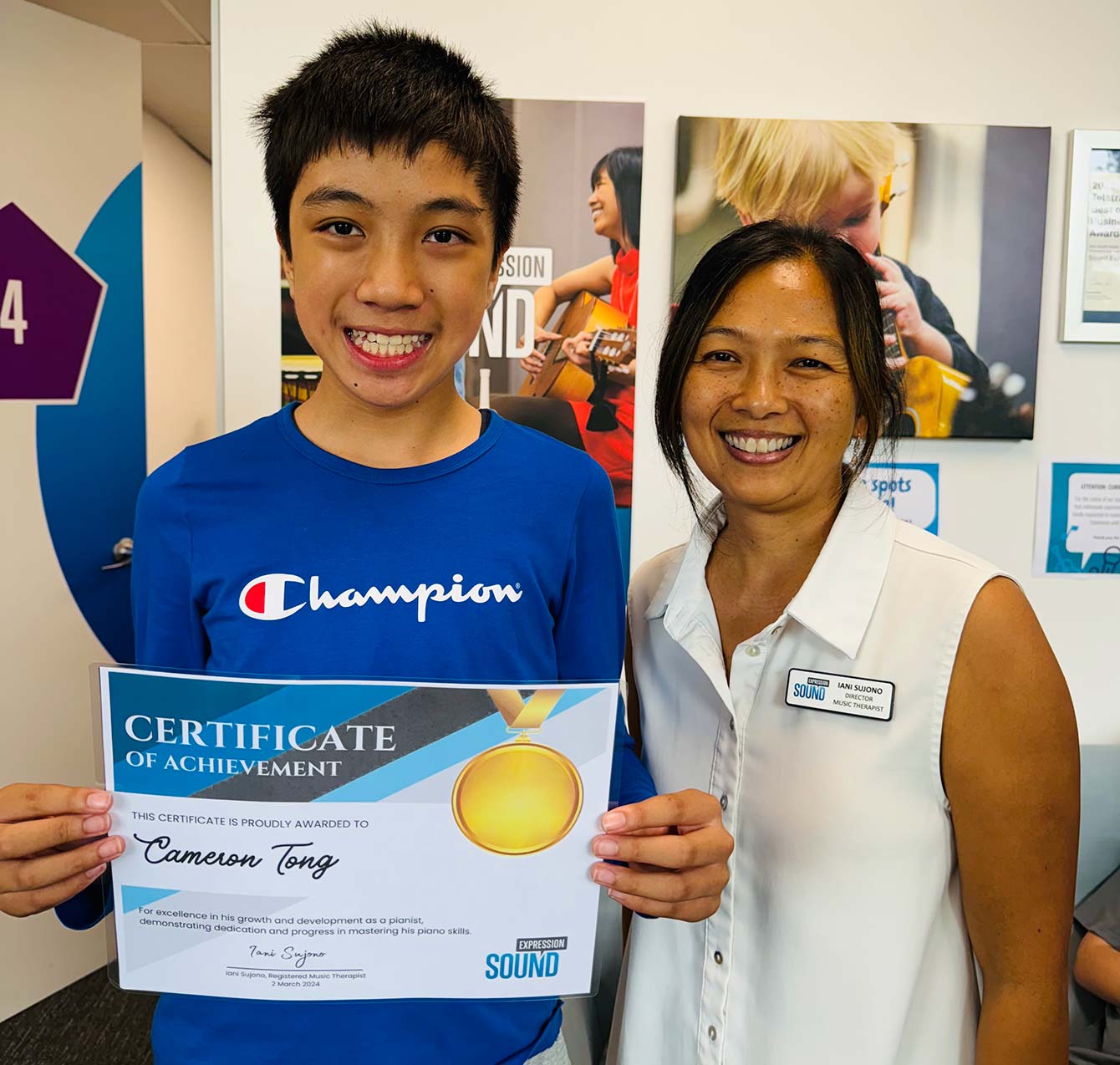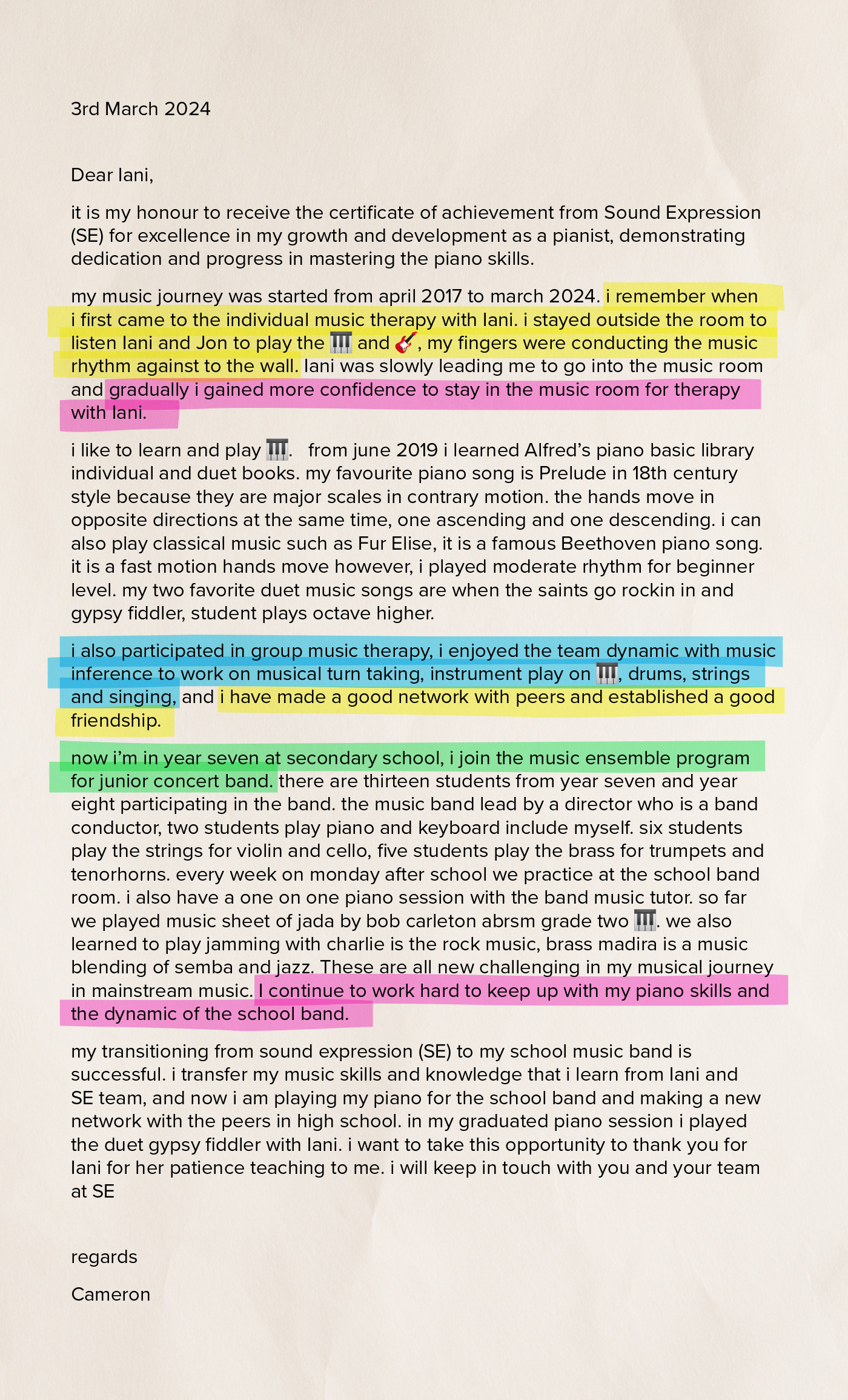A Reflection on Growth and Transition
In April 2017 Cameron came for the first time to Sound Expression with his parents, starting a seven-year musical journey that would shape his growth and confidence as an individual. At just 5 years old, Cameron exhibited curiosity but also anxiety, a common experience for neurodivergent people navigating new environments.
During the initial weeks of music therapy, the focus was simply to get Cameron accustomed to the routine of coming to Sound Expression. Cameron would investigate the various rooms at our clinic, but he hesitated, choosing to linger outside his music therapy room, absorbing the melodies and rhythms played by his music therapist Iani Sujono, from a distance.
Most parents might have given up and think that their child is not responding to music therapy, but not Cameron’s parents. They diligently brought Cameron to our clinic every week, because they knew their son had a tremendous affinity for music. They recognised his innate affinity for music and remained strong in their commitment to pursue music therapy as a therapeutic intervention for their child.
Although Cameron initially did not choose to play an instrument, he showed interest and was carefully watching and listening to all the music played by his therapist. Small yet significant positive signs, such as putting two steps forward into the music therapy room, watching which bells were being played, and coming back to the room when there was something interesting being played in the music, were evidence of Cameron’s gradual but transformative music therapy journey, shaped by his unique perspective as a neurodivergent child.
Cameron would like us to share this letter with you all. We are very proud of all of his achievements!
Download PDF version
Over time, with patience and encouragement, Cameron gained the courage to step into the music therapy room, signalling the beginning of a trusting and collaborative relationship. Through music, Cameron found a means of expression and connection that overcame traditional communication barriers. He would not use his language readily to communicate, but he certainly had a lot to share and say through his music! One of the amazing things about music therapy is that two people can share humour, conversation, emotion and engage socially, without the need to use language. You can do so much communicating and socialising through music! For someone like Cameron, who did not wish to use his verbal speech much, music therapy became the perfect way to help him develop his communication and social skills. As Cameron’s confidence grew, so did his ability to communicate, engage socially, and musically.
Cameron’s journey began with individual music therapy sessions. As he progressed in his communication and collaboration, he transitioned to group music therapy to gain the skills to engage with his peers. Recognising his musical talent, Cameron’s parents sought supported music lessons at our clinic, leading to a new chapter in his musical development.
Cameron embraced his supported music lessons, enjoying reading and playing music notes on staves, as well as playing the piano aurally. He loved doing ‘tricks’ with his music – Cameron would attempt to play piano pieces in reverse, showcasing his joyful exploration of musical possibilities. Playing in contrary motion made him giggle! He was such an experimenter and creative individual!
Fast-forward 7 years, Cameron is now in year 7 at his secondary school. He has joined his school band and is connecting socially with his peers through the band. He is also participating in mainstream music lessons. He no longer needs his supported music lessons and group music therapy at Sound Expression. Our job as his music therapists is done!
As we celebrate Cameron’s achievements and bid farewell to this chapter of his development, we are reminded of the profound impact of music in fostering growth, confidence and connection for neurodivergent individuals. Cameron’s story serves as an inspiration to us all, reaffirming the enduring value of music in enriching lives and nurturing individual potential.
Get to know Registered Music Therapist Iani Sujono.
See more client stories — follow us on Facebook and Instagram!



